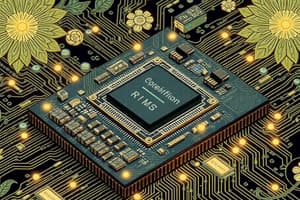Podcast
Questions and Answers
What does memory management in a System on Chip (SoC) primarily involve?
What does memory management in a System on Chip (SoC) primarily involve?
- Designing the physical layout of the chip
- Determining the clock speed of the chip
- Developing the user interface of the chip
- Allocating and freeing up space efficiently (correct)
Which model is typically followed in the design process of a System on Chip (SoC)?
Which model is typically followed in the design process of a System on Chip (SoC)?
- V-Model
- Waterfall model (correct)
- Agile model
- Spiral model
What is deep submicron technology in the context of SoCs?
What is deep submicron technology in the context of SoCs?
- A software development methodology
- Designing large-scale integrated circuits
- Fabrication processes for transistors smaller than 90nm (correct)
- Memory optimization techniques
Which of the following is NOT a stage in the design flow of an SoC according to the text?
Which of the following is NOT a stage in the design flow of an SoC according to the text?
In the context of SoCs, what is a key aspect of memory management that contributes to optimal performance?
In the context of SoCs, what is a key aspect of memory management that contributes to optimal performance?
What is the purpose of using deep submicron technology in creating transistors for SoCs?
What is the purpose of using deep submicron technology in creating transistors for SoCs?
What is the primary benefit of smaller transistors in chip design?
What is the primary benefit of smaller transistors in chip design?
How does the design matrix aid in System on Chip (SoC) design?
How does the design matrix aid in System on Chip (SoC) design?
What does noise margin refer to in chip design?
What does noise margin refer to in chip design?
Why is reliability crucial in System on Chip design?
Why is reliability crucial in System on Chip design?
What is the purpose of fan in fan out (FIFO) technique in an SoC?
What is the purpose of fan in fan out (FIFO) technique in an SoC?
How do advanced microcontroller bus architectures benefit SoC design?
How do advanced microcontroller bus architectures benefit SoC design?
Study Notes
System on Chip Overview
A System on Chip (SoC) is a type of integrated circuit design that integrates all components of a computer or other electronic systems onto a single chip. This approach allows for more compact devices with reduced power consumption while maintaining functionality comparable to traditional systems with multiple chips. SoCs have been used in various applications such as mobile phones, digital cameras, and automobiles. Some key aspects of SoCs include:
Memory Management
Memory management refers to how data is stored and accessed within a computing device. In an SoC, managing memory involves allocating and freeing up space efficiently to ensure optimal performance and minimal delays. This includes handling tasks like caching, paging, and virtual memory.
Design Flow
The process of designing an SoC typically follows a systematic method called the waterfall model, which breaks down the development process into distinct stages. These stages include requirements analysis, preliminary design, high-level design, low-level design, draft implementation, release, and maintenance. Each stage builds upon the previous one, ensuring consistency and accuracy throughout the entire design process.
Deep Submicron Technology
Deep submicron technology refers to the fabrication processes used to create transistors smaller than 90 nanometers (nm) in size. Smaller transistors allow for higher integration density, leading to faster processing speeds and increased energy efficiency. However, this also presents challenges in manufacturing due to the increased complexity involved in creating these tiny devices.
Design Matrix
The design matrix contains information about the different types of logic cells available in an SoC, along with their corresponding timing parameters. This helps designers select the appropriate cell for each logical function, optimizing speed and minimizing power consumption during the final layout phase.
Reliability
Reliability plays a crucial role in SoC design, as it ensures the consistent operation and longevity of the device. Factors contributing to reliability include component selection, thermal considerations, and testing procedures.
Static Gate Behavior
Static gate behavior refers to the behavior of transistor gates when they are not actively switching states. Properly designed circuits minimize leakage current when transistors are off, reducing power consumption and extending battery life.
Noise Margin
Noise margin is the amount by which a signal can change without causing errors. A larger noise margin increases the robustness of the circuit against external interference, ensuring accurate communication between components.
Fan In Fan Out
Fan in fan out (FIFO) is a technique used to regulate data transfer rates between blocks of an SoC. It balances the load on interconnects by storing packets of data temporarily before releasing them to the destination block, preventing bottlenecks and improving overall performance.
Advance Microcontroller Bus Architecture
Advanced microcontroller bus architectures improve the speed and scalability of data transfer between different parts of an SoC. Examples include the Advanced High-Performance Bus (AHB), the Arm CoreLink Interface, and the AMBA® AXI™ Interface. These buses facilitate efficient communication among various modules, enabling complex functions to operate smoothly within the SoC.
In summary, a System on Chip combines various functionalities onto a single chip, allowing for miniaturization, improved performance, and lower power consumption. Its design involves careful consideration of factors like memory management, design flow, deep submicron technology, and many others to ensure optimal functionality and user experience.
Studying That Suits You
Use AI to generate personalized quizzes and flashcards to suit your learning preferences.
Description
Test your knowledge about System on Chip (SoC) design principles, including memory management, design flow, deep submicron technology, design matrix, reliability, static gate behavior, noise margin, fan in fan out, and advanced microcontroller bus architecture.




